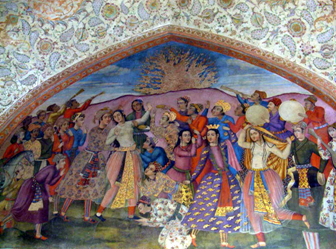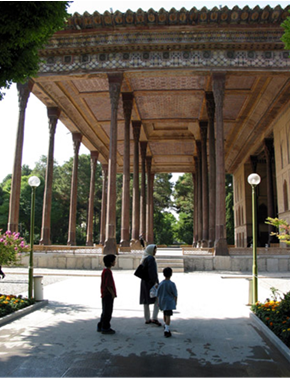Introduction
Using skill and imaginations to communicate thoughts and observations, create emotions, and engage audiences can be referred to as art. Design simply means composition.
These two terms are integrated to establish the concept of transforming what is in mind to a compositional structure that can be seen by others. Features that form a finished artwork may be expressed through drawings or actual creations like buildings and sculptures (Nelson and Shiff, p. 56).
This paper describes Chehelsouton pavilion as a form of art and design it analyzes the creativity used during its construction, the originality of the materials used, the art applied in designing it as well as the intended use of it as a palace.
It seeks to establish the relationship between history and art, how these two variables are dependent on each other and their implications on modern art.
This brings us to the result of art and design, which is the aestheticism, and the appeal it gives to the audience. The audience refers to the people who used the pavilion as well as the tourists who visit to admire and appreciate it as a form of art.
Chehelsouton as a form of art and design
Chehelsouton is an ancient pavilion built in 1647 by Shah Abbas II. This pavilion was used by the King and his successors to receive dignitaries and ambassadors. It was built inside vast Royal Park round an earlier building erected by Shah Abbas I.
It was designed with twenty columns at the far end of a long pool, which when reflected in the waters of the fountain appear to be forty. This gave it the name “Chehelsouton” meaning forty columns. It contains frescoes and paintings on ceramic depicting historical scenes like reception of Kings and victories achieved by kings, such as the conquering of the Indian army in Kamal during 1739.
These paintings also express traditions like events of celebrating the joy and love. The pavilion has a brilliantly painted interior with a host of human figures. This includes various battlefield scenes, as well as audiences conducted by the Shah.
This is conducted in conjunction with rulers who bordered the empire from the eastern side. Chehelsouton grew by accretion of new additions such as chambers and halls into the existing structures over the years to come up with the current pavilion.
The palace has become a museum of paintings and ceramics, and this has attracted millions of tourists both foreign and domestic. This tourist attraction has maintained the idea of its conception, which included the reception of visitors, entertainment and hospitality to the palace’s guests (Ruggles, p. 102).
From the above description of the pavilion, the following is an illustration of how history is expressed through art and design. The relationship between material and design in Isfahan exhibited some differences when compared to that in the Western tradition.
It should be noted that painters from the west were known to impose a design on an artificial surface that was limited. This was due to the predetermined space provided to be used in imposing a figure on the material. However, Isfahan painters and sculptors did not adhere to this. They were not known to be limited and controlled by the predetermined space in their work.
On the contrary, these artists made their designs conform to the outlines that were naturally determined by the materials they used. In most cases, these materials included an iwan, talar or portico. Isfahan art embraced naturalism, and this proved to be a critical factor of this form of art.
In addition, this demonstrated outstanding abilities of the artists in incorporating nature into their compositions. From such art, we are able to learn the environment of the Isfahans, as well as their competence as skillful artists (Ruggles, p. 113).
The trend has changed greatly in the modern times. In essence, art history is regarded as an aspect that emphasizes on educating individuals on the evaluation and interpretation of art influenced by their own views. This we can say has been discovered through analyzing the originality of arts that were practiced in the past.
For instance in the case of Isfahan, the technique used in creating the pavilion was original in the fact that it was made out of what existed naturally, the pool, the gardens and the plain woods used to create the columns.
The designers only added their creativity on the nature, and this is what gives art the beauty and appeal expected of it. This form of art shows that the people identified with their environment, this association differentiates natural art from the artificial one (Udo, p. 149).
Emotions have been created in the paintings that were included in the pavilion; for example, in the following picture it is clear that victory in battles called for celebration and brought joy to the people. This joy was communicated by merely using the paintings without words to describe them.

A painting showing the victory of Nader shah over Mohammed of India. It shows the celebration of joy and love.
Source: Persia Articles
Transition has been outlined from the fact that there were additions to the original idea of the pavilion in the past years. This explains that history is a series of events that are connected to one another. On the other hand, art can be used to illustrate the transformation from old to modern times without separating the two.
From this pavilion, Culture of the Isfahan residents is evident. First, the main reason for the construction of this palace was the reception of kings, dignitaries, and ambassadors. This tells us that the Isfahan residents had a culture of treating visitors with the utmost respect and hospitality. From this history of visitors’ reception, it has resulted to the same culture being practiced at a modern setting where tourists, both local and foreign, visit Chehelsouton as an art that attracts tourism. On the contrary, taste is determined by culture, ideas and imaginations that transform to creativity are based on experiences which are as the result of interactions and practices of a given society. This is how culture shapes history (Arnold, p. 54).
Not all art is beautiful to the eyes, but it remains an art. The value of an artist’s creation is in the composition and the expression intended. It can be used to pass a message and may not be accompanied by an aesthetic value. For example in the painting below, the artist has communicated that the people of Isfahan used to go to battles, thus expressing remorse (Ruggles, p. 160).

A painting showing battle
Source: Persia Articles
Architecture is a major historic form of art that has evolved from the ancient, simple structures to the significantly advanced, modern ones. In Chehelsouton, at first the skillful designers were able to base their construction on just a stone, the pool and pillars. Other additions were introduced over the years. This implies that, through observation of historic arts and initial ideas, history gives new, creative ideas to designers. This helps them come up with inventive architectural designs (Ruggles, p. 156).
Specific historical scenes such as the reception for an Uzbek King in 1646 create memorable events that artists and designers treasure. Such histories led to the invention of a veritable museum of Persian painting and ceramics. Therefore, studying historic forms of art creates ideas which further improve this art, for instance, paintings made to treasure historic events led to the birth of museums. It is through the creation of this museum that the idea of maintaining the pavilion, not as a reception for dignitaries, but a tourist attraction came up. Transforming this palace into a museum helps the residents study their history as well as identify with their culture that dates back to the 17th century (Ruggles, p. 163).

Tourists at the entrance of the pavilion
Source: Tamara Ebrahimpour: Isfahan’s Chehel Sotoun: A Reflection of Beauty.
Conclusion
History plays a major role in art and design because creativity and composition requires one to compare and contrast it to another work of art. As one explores the fascinating world of art with beautiful collections of thousands of human experience, ideas are born, and this inspires artists to find beauty in man made forms.
It is an aesthetic object which is meant to be admired and appreciated for its value. Individuals cannot escape from viewing works of art in the context of time. This is because it is varied, and cannot be reduced to a given context. Art and design appreciation introduces excitement to life as it is part of history creation.
Works Cited
Arnold, Dana. Art History: A very short introduction.Oxford.Oxford University Press, 2004. Print.
Ebrahimpour, Tamara. Isfahan’s Chehel Sotoun: A Reflection of Beauty. 2012. Web.
Nelson, Robert S, and Richard Shiff. Critical terms for Art History. Chicago.University of Chicago Press, 2003. Print.
Persia Articles. Frescos in the main hall of the Chehel Sotoun in Isfahan. 2012. Web.
Ruggles, D. Fairchild. Islamic Art and Visual Culture: An Anthology of Sources. Malden, MA: Wiley-Blackwell, 2011. Print.
Udo, Kultermann.The History of Art History.New York: Abaris books,1993. Print.